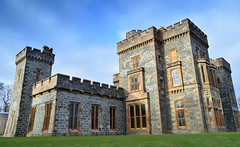Invermark Castle
16th century tower style house in Angus Glens with interesting history. It was used by local people to protect themselves and their cattle from rustlers coming dow the glen to rustle.
Early 16th century with early 17th century additions and alterations (see Notes). 4-storey and attic, rectangular-plan, roofless tower house with 17th century bartizan corbelled out at 3rd floor, round-arched entrance with iron yett at 1st floor, regularly-spaced horizontal gun loops at ground level to all elevations, gable and wall-head stacks. Very irregular fenestration. Random granite and schist boulders and rubble with red sandstone margins. Intermittent remains of eaves cornice. The castle has rounded corners, corbelled to square at 3rd floor. Chamfered window margins to older part; rounded margins to later windows; relieving arches above most windows.
Invermark Castle was built around 1526 by the Lindsays and was used as a refuge by the locals when Highland caterans or raiders descended on the Glen to steal cattle and whatever else they could find. In 1659, when the Laird bestowed a grant for the reader or schoolmaster, he bound himself and his successors to pay the whole stipend in the event of "a general vastatione of the paroche by Highlanders or otherwise."
During one such raid, half the cattle and sheep in the Glen were carried off and five Glenesk men died trying to stop them. The castle was used by young David Lindsay, in 1607, after he had killed Lord Spynie in Edinburgh, after a long-standing quarrel. James Carnegie, Lord Balnamoon was another who sought shelter in Invermark Castle. He hid from government troops there after Culloden.
Further up the Glen, in Glen Mark, there is a cave called "Bonnymune's Cave" where he successfully eluded the Redcoats until he was pardoned. The local people brought him food and warned him when the soldiers were about. Invermark Castle is about 65 feet high, 38 feet long and 27 feet broad. The basement walls are over 5 feet thick. The doorway is around 9 feet above the ground and although the wooden door has long gone, the iron 'yett' is still in position. Tradition says the yett was made locally of iron mined in Glenesk, but it does not seem to have been made originally for Invermark, as the shape of the yett does not correspond with the opening.
It is probable that entry was effected by a draw-bridge from the castle onto the roof of one of the outbuildings. The outbuildings were removed about 1803 to supply materials for building the Lochee Church and Manse. The Rowan Tower, properly called the Maule Cairn, was built in 1866 by Fox Maule, 11the Earl of Dalhousie. It was erected as a memorial to members of his family who had died, including his brother Lauderdale Maule, M.P., who died of cholera during the Crimean War. Built by Robert Dinnie of Birse, who also built a bridge at Gleneffock and helped to build the Maule Memorial Church.
The tower stands 50 feet high and 38 feet in diameter, and was largely rebuilt in 1887 after a slip. This work was done by Stewart Porter of Cuttlehaugh, who was an apprentice to Robert Dinnie. The Queen's Well is a crown shaped monument built over a spring well in Glenmark. It was built to commemorate a visit made to Invermark Lodge, in September 1861, by Queen Victoria and Prince Albert. They made the journey from Balmoral to Glenesk over Mount Keen on horseback, and stopped at the well to drink.
Opening Times
Castle is abandoned and can be visited on foot. Take care of the general structure which is not safe.











